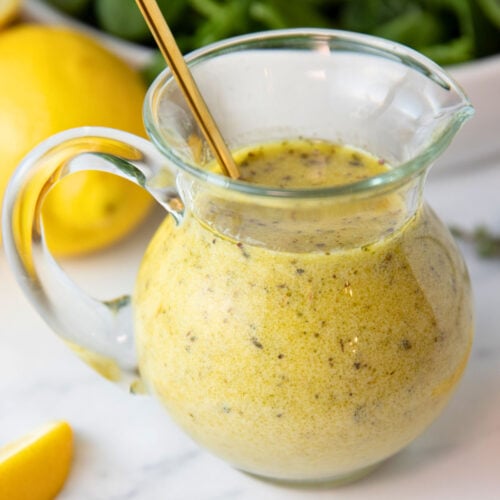Lemon vinaigrette dressing is a simple, versatile sauce that brightens salads and enhances a variety of dishes. It combines fresh lemon juice, oil, and seasonings to create a light, tangy flavor. Its key appeal lies in balancing acidity and richness without overpowering the natural taste of ingredients.
Many chefs prefer lemon vinaigrette for its ability to complement greens, vegetables, and even grilled proteins. Its straightforward recipe makes it easy to customize, adjusting acidity or sweetness according to personal taste. This dressing offers a fresh alternative to creamy or heavy dressings.
Understanding the basics of lemon vinaigrette can help anyone elevate everyday meals with minimal effort. Learning how to make it from scratch allows control over quality and flavor, making it a valuable addition to any kitchen.

How to Make Lemon Vinaigrette Dressing
A successful lemon vinaigrette depends on selecting the right ingredients, carefully combining them, and adjusting the flavors to taste. Each step builds on clear proportions and balance for optimal results.
Ingredients and Substitutions
The base of lemon vinaigrette is fresh lemon juice and an oil, usually olive oil. Typically, a 1:3 ratio of acid to oil is used. For example, 1 tablespoon lemon juice to 3 tablespoons olive oil.
Common additions include Dijon mustard, salt, and black pepper for seasoning. Honey or maple syrup can add mild sweetness if desired.
Substitutes for olive oil include avocado or grapeseed oil for a lighter texture. Lime juice or white wine vinegar can replace lemon juice but will alter the flavor profile. Fresh herbs like parsley or basil can be added for variation.
| Ingredient | Typical Amount | Common Substitute |
|---|---|---|
| Lemon juice | 1 tablespoon | Lime juice, white wine vinegar |
| Olive oil | 3 tablespoons | Avocado oil, grapeseed oil |
| Dijon mustard | 1 teaspoon | Yellow mustard |
| Sweetener | 1 teaspoon (optional) | Honey, maple syrup |
Step-by-Step Preparation
Start by measuring the lemon juice and oil separately. Place the lemon juice in a bowl or jar first.
Add Dijon mustard and any sweetener, then stir or whisk lightly. Slowly drizzle in the oil while continuously whisking to emulsify the dressing, creating a smooth mixture.
Season with salt and freshly ground black pepper to taste. Adjust seasoning after tasting. For a thicker dressing, some recipes suggest adding a small amount of mayonnaise or yogurt, but traditional vinaigrette remains oil-based.
Store any unused dressing in the refrigerator for up to one week, and shake or whisk again before use.
Tips for Balancing Flavors
Acidity from lemon juice is strong; balancing it with enough oil prevents harshness. Start with less lemon juice and add more gradually.
Salt enhances flavors but should be added in small increments. Taste frequently during the process to avoid over-seasoning.
If the dressing tastes too sharp, a pinch of sugar or honey reduces bitterness. If too bland, add more lemon juice or mustard for brightness and depth.
Whisking continuously while adding oil ensures the dressing emulsifies, creating a uniform texture rather than separating quickly.
Serving Ideas and Storage
Lemon vinaigrette is versatile and complements many dishes with its bright, acidic flavor. It can be used in various ways, highlighting fresh ingredients and enhancing textures. Proper storage ensures it maintains freshness and flavor.
Serving Suggestions
Lemon vinaigrette is ideal as a dressing for mixed greens, arugula, or spinach. It can be drizzled over grilled vegetables to add a citrusy brightness. It also works well as a light marinade for chicken or fish before cooking.
Using it as a finishing touch on roasted potatoes or steamed asparagus provides a fresh contrast to rich flavors. It can be whisked into grain bowls or pasta salads to brighten the overall dish without overpowering other ingredients.
Pairing with Salads and Dishes
Lemon vinaigrette pairs well with salads featuring mild greens, feta, olives, or nuts. It complements Mediterranean-style salads with cucumbers, tomatoes, and red onions. It balances creamy or hearty salads, cutting through richness with acidity.
The dressing enhances simple roasted meats or seafood, such as grilled shrimp or seared salmon. It is suitable for drizzling on lentil or chickpea salads, adding a refreshing note. Its acidity pairs well with dishes that contain garlic, herbs, or mustard.
Storage and Shelf Life
Store lemon vinaigrette in a clean, airtight container in the refrigerator. It typically lasts about one week when properly refrigerated. The oil and lemon juice may separate; shaking or whisking before use will re-emulsify the dressing.
Avoid storing it at room temperature for extended periods to prevent spoilage. If the vinaigrette develops an off smell, discoloration, or mold, discard it immediately. Using fresh lemon juice and high-quality oil at preparation extends shelf life.
